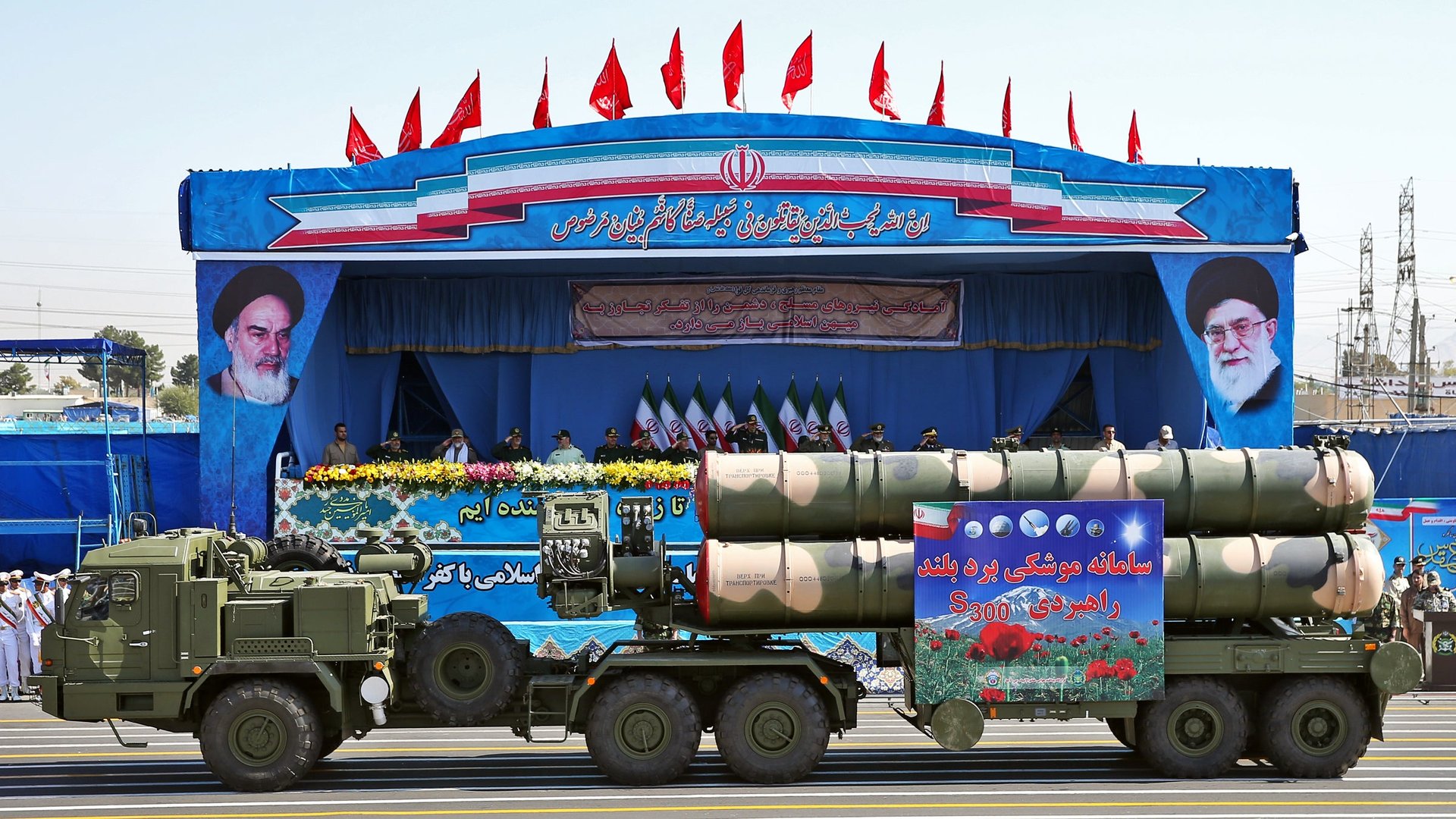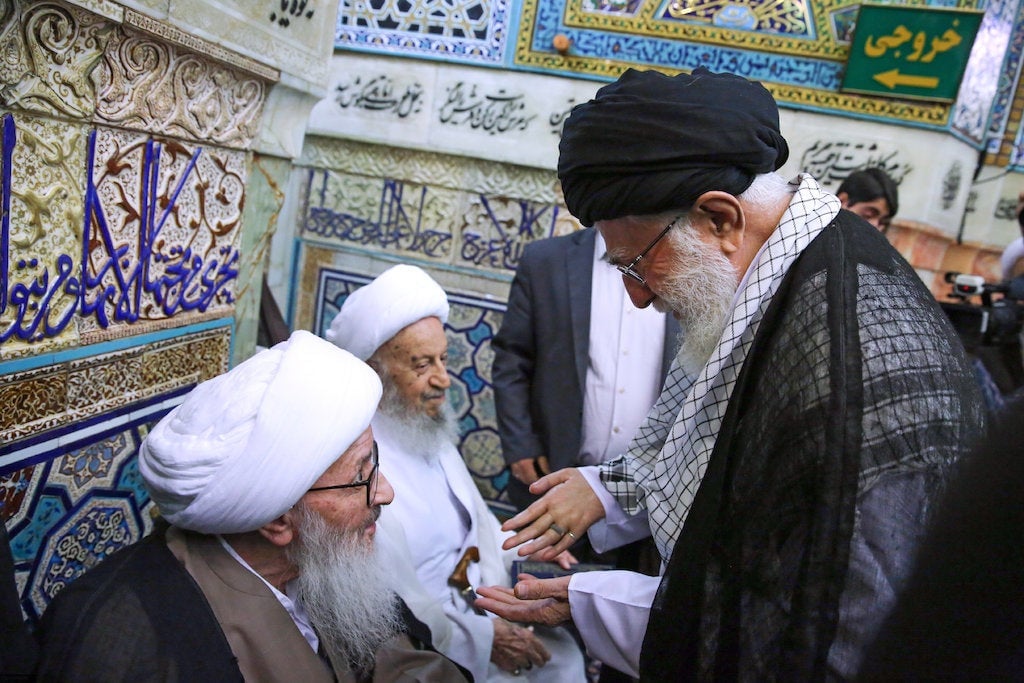Satellite images show a missile launcher following Iran’s Ayatollah Khamenei
Last month, Ayatollah Ali Khamenei went to the Sacred Shrine of Imam Ridha in Masshad, Iran, to attend the ritual cleaning of the Muslim saint’s tomb. But being the supreme leader of Iran is not all rites and photo opportunities: There’s also the Great Satan, fractious internal politics, and arch-nemesis Israel to worry about.


Last month, Ayatollah Ali Khamenei went to the Sacred Shrine of Imam Ridha in Masshad, Iran, to attend the ritual cleaning of the Muslim saint’s tomb. But being the supreme leader of Iran is not all rites and photo opportunities: There’s also the Great Satan, fractious internal politics, and arch-nemesis Israel to worry about.
That may be why Khamenei was spotted apparently bringing a Russian-built missile launcher on a trip from Iran’s capital, Tehran, to Masshad, in the north-eastern corner of the country.
The maneuvers shine a light on the defensive mindset of the regime during a critical diplomatic effort this month: At the United Nations General Assembly in New York, Iran will be hunting for international support to relieve US sanctions scheduled to resume on Nov. 4, because president Donald Trump left a global agreement to restrict Iran’s nuclear weapons research.
“This weapon system is a pretty big deal,” says Daniel Byman, a security researcher at the Brookings Institute focused on the Middle East. It’s one of the few weapons capable of making the most powerful air forces, like those of the United States or Israel, think twice about direct attacks, Byman says, forcing them “to fly farther away and otherwise be less able to strike with precision.”

The system accompanying Khamenei is known in the US as the S-300. It includes truck-mounted missile launchers and radar sensors to guide the missiles to their targets. It can shoot down drones, planes, and perhaps even other missiles.
Naturally, spies are very interested in watching weapons like these, since they are the first line of defense from outside attack. ”Everyone wants to keep track of where capable [surface to air missiles] are at, because, God forbid, if a country wanted to do regime change, the first course of action is suppression of enemy air defenses,” a former US intelligence analyst tells Quartz.
The same is true for independent security analysts using commercial satellite imagery, who discovered a telling pattern in how the missiles are deployed and shared them with Quartz.
Missile mover
Iran is believed to have four S-300 systems—two in Tehran, one in the city of Isfahan, and one in the city of Bushir, where there is a nuclear power plant. One day in 2018, however, one of the Tehran systems disappeared.
Analysts combing satellite imagery of Iran were able to figure out where it went: They found it an airport in Masshad.
There aren’t many of these systems floating around, and observers soon realized the decision to move the S-300 to Masshad coincided with a visit by Khamenei. Looking through historical imagery, analysts identified three occasions when Iran’s military flew the missile defense system to Iran’s second largest-city at the same time as Khamenei’s official visits. In July 2017, Khamenei went to Masshad, and so did the air defense system; as it did in March and August 2018.
A former US government intelligence analyst, who was granted anonymity because they are not authorized by their employers to discuss these movements, alerted Quartz to the pattern of behavior. Renny Barbiarz, an instructor at Johns Hopkins University and an analyst for AllSource Analysis, also said the imagery demonstrates a pattern of Iran deploying air defenses to protect their head of state.
“For the regime security apparatus, it makes sense that Khamenei is protected all the time, and this is them extending that to air defense,” Behnam Ben Taleblu, an Iran analyst at the Foundation for Defense of Democracies, tells Quartz.
A key caveat is that, beyond the space surveillance and knowledge of Khamenei’s movements, the researchers don’t have additional evidence to corroborate the idea that the Ayatollah’s movements and the missile systems are connected.
“We are not in a position to discuss, confirm or deny the premise of your story,” a US Defense Intelligence Agency spokesperson told Quartz, a response known as a “Glomar.” The Iranian interests section at the Pakistani embassy in Washington did not respond to questions.
More than a missile
Iran’s S-300s were purchased from Russia in 2016. The deal came after international sanctions were lifted in a global pact to prevent Iran from acquiring nuclear weapons.
The S-300’s radar is capable of tracking dozens of aerial targets at ranges of hundreds of miles, and is supposedly capable of destroying cruise and ballistic missiles—although the record of missile interceptors of this style is not good.
Israel, which views Iran as an existential threat, had pushed Russia not to sell Iran the S-300. The new defenses could limit Israel’s ability to strike inside Iran in operations similar to the one that destroyed a nuclear reactor in Osirak, Iraq in 1981. Iranian generals said the new missiles are deployed to protect its nuclear infrastructure, though that may be propaganda—a key advantage of these mobile launchers is the ability to hide them and surprise adversaries.
However, Iran moving a mobile missile launcher alongside its leader suggests that the country does not have sufficient defenses to cover its entire territory. That may suggest a lack of funds, or political difficulty obtaining enough equipment from its patron in Moscow.
Aerial anxieties
Governments of all kinds take precautions to protect the head of state from potential aerial attack; the airspace over Washington, DC, for example, is tightly controlled and patrolled. (Sometimes, not that tightly.) The re-positioning of the missiles may simply be a prudence by Iranian security forces as international tensions rise.
“The beginning of the Iraq war in 2003 was the leadership strike [when the US launched missiles at Saddam Hussein’s suspected residence],” Byman says. ”Israel of course has engaged in leadership targeting. I think the Iranians have understandable reason to be a little paranoid about this.”
Masshad is also near Iran’s border with Afghanistan, 50 miles from Kashmar, the city where Iran captured a US drone by hacking into its avionics system. The missile system may be designed to deter US drones from snooping near the border while the Ayatollah is there.
Another possible explanation for the maneuver is a fear of internal enemies. During a 2016 coup attempt in Turkey, rebel pilots attacked government installations. But Khaemenei’s religious credentials, as well as the existence of loyal security forces like Iranian Revolutionary Guards that parallel the military, make such an action much less likely.
Once US sanctions go into effect next month, Iran’s leaders will face a decision—to continue their diplomatic efforts and wait for political changes in Washington, DC; to escalate their conflict with the US in proxy battles across the Middle East; or perhaps to attempt a negotiated gambit akin to North Korea’s engagement with the Trump administration. But one thing is clear: As Iran and the West spiral towards conflict once again, it’s clear that Iran is worried about offensive action by its enemies.
“It’s less important what Western defense officials and Western analyst think,” Taleblu says. “If the regime is doing this, they think it is important and they think it might be a possibility.”